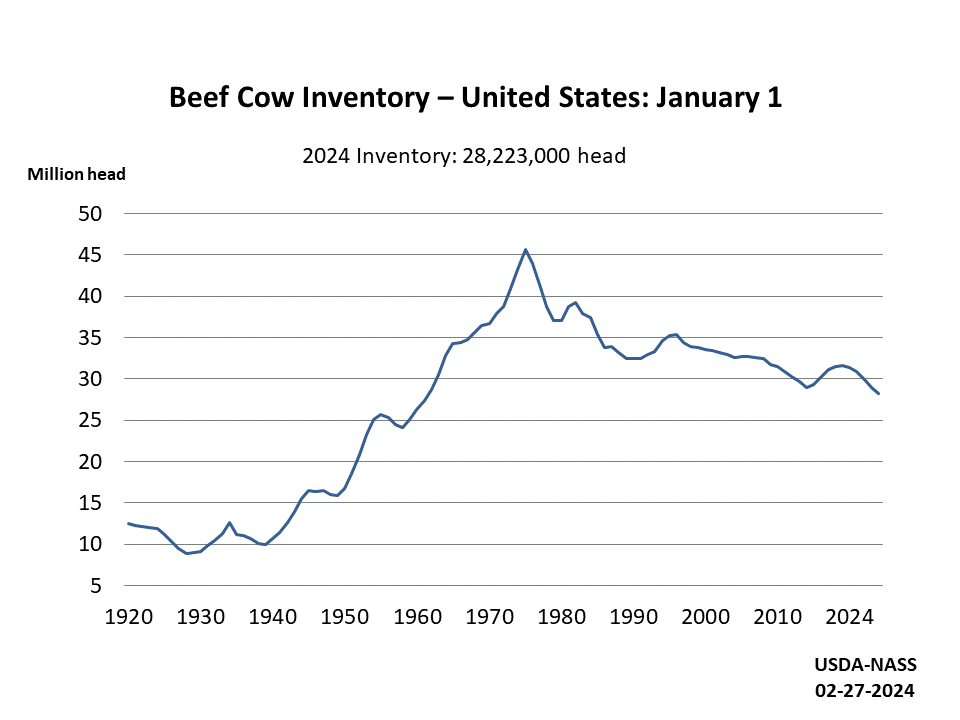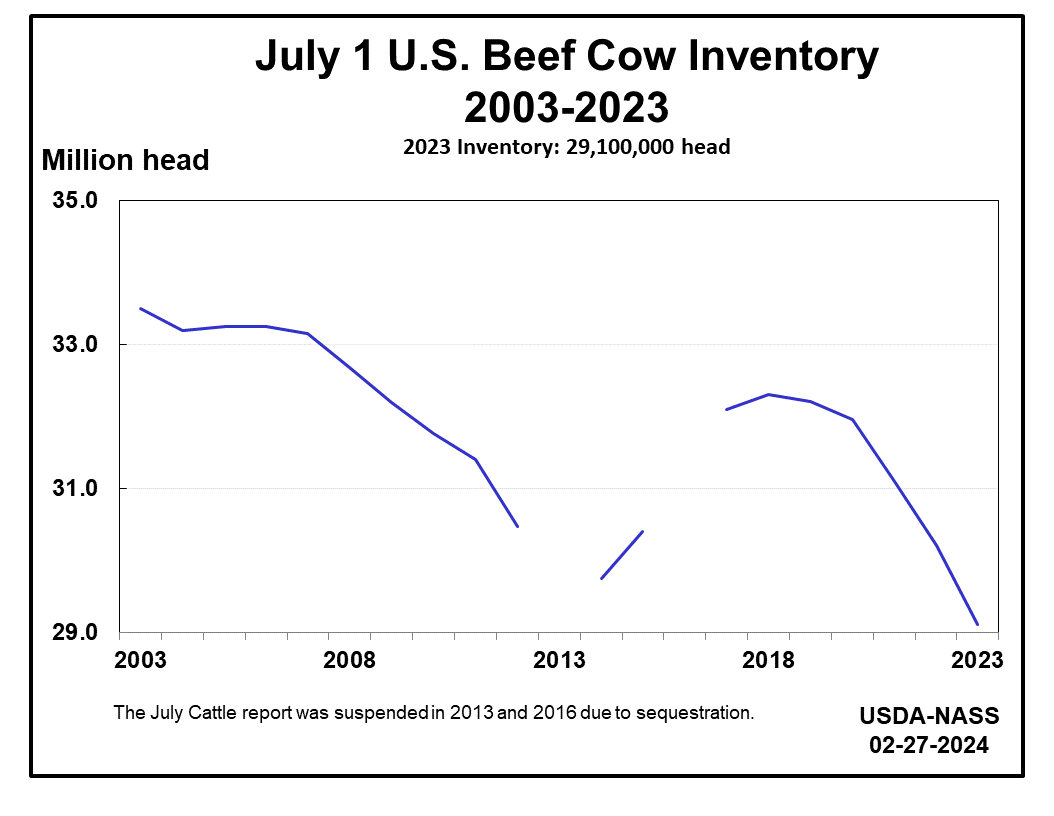- Data & Statistics
Access Quick Stats (searchable database)
The Quick Stats Database is the most comprehensive tool for accessing agricultural data published by NASS. It allows you to customize your query by commodity, location, or time period.
Access Quick Stats Lite
Quick Stats Lite provides a more structured approach to get commonly requested statistics from our online database.
Explore Statistics
County Level Information
Geospatial Data & Interactive Maps
- Publications
Browse NASS Reports
- by Subject
- by Date (Reports Calendar)
- by Title/Release Day
- by Keyword
- Guide to Products and Services
Additional Reports
Historical Publications
- Archived Ag Census Reports (2002 and prior - published every 5 years)
- Annual Agricultural Statistics
- Statistical Bulletins (final estimates, 1987 to 2012
- Track Records: (crops, livestock, grain stocks)
- Trends 20th century
- Price Reactions (after crop or livestock reports)
Receive Reports by Email:
- Newsroom
News Releases
03/28/24 United States hog inventory up 1%
03/28/24 US farmers expect to plant less corn and more soybean acres
03/26/24 USDA to host Data Users’ Meeting to gather public input on statistical programs
Read More News
ASB Notices
04/15/24 NASS appoints Lance Honig as new ASB Chair
04/09/24 NASS discontinues select 2024 data collection programs and reports
04/04/24 NASS announces program changes following five-year review
02/23/24 NASS Delays Cold Storage Data Release
12/19/23 NASS seeks public input during survey program review
Read More Notices
Videos
02/13/24 2022 Census of Agriculture Data Highlights
02/13/24 How to Find 2022 Census of Agriculture Data
02/13/24 2022 Census of Agriculture Data Release Event
07/16/21 What is a Farm?
08/05/20 The NASS Mission: We do it for you
View More Videos
ASB Briefings
04/17/24 National Hemp Report (April 2024)
04/11/24 Crop Production (April 2024)
03/28/24 Quarterly Hogs and Pigs (March 2024)
03/28/24 Grain Stocks, Prospective Plantings, Rice Stocks (March 2024)
03/08/24 Crop Production (March 2024)
View More Briefings
- Surveys
- Census
- About NASS
Structure and Organization
- Agency Overview
- NASS Biographies
- Organizational Chart
- Assistance to Other Organizations
- International Programs
- NASS Strategic Plan for FY 2022-2026
- USDA Strategic Goals
- NASS Climate Adaptation and Resilience Plan
Guiding Principles
- Mission and Core Values
- Keeping Data Safe
- Confidentiality Pledge
- Security Pledge
- Security Statement
- Statement of Commitment to Scientific Integrity
- Regulations Guiding NASS
- Information Quality
Civil Rights
- USDA and NASS Civil Rights Policy Statement
- Civil Rights Accountability Policy and Procedures
- No FEAR Act Notice
- No FEAR Act - NASS Data
-
REE Reasonable Accommodations and Personal Assistance Services
- NASS Disability Affirmative Action Plan
- How to File an EEO Complaint
- Contact information for NASS Civil Rights Office
Work at NASS
Education and Outreach
- Understanding Ag Statistics
- Data Users' Meetings
- Morris Hansen Lecture
- International Conference on Agricultural Statistics
History and Procedures
- Agricultural Statistics Board and Lockup
- Agricultural Statistics: A Historical Timeline
- The Story of U.S. Agricultural Estimates
- As We Recall: The Growth of Agricultural Estimates, 1933-1961
-
Safeguarding America's Agricultural Statistics Report and Video
- History of Ag Statistics
- Report Procedures
- An Evolving Statistical Service
- Fact Finders for Agriculture
- Hall of Fame
- Contact Us
Mailing Address:
USDA-NASS
1400 Independence Ave., SW
Washington, DC 20250Survey FAQs and Contact Us:
Access FAQs or submit a question.
Data Inquiries:
Hours: 7:30 a.m. - 4:00 p.m. Eastern Time
Monday - Friday, except federal holidays
Toll-Free: (800) 727-9540Media Inquiries:
Other USDA Inquiries:
Hours: 9:00 a.m. - 5:30 p.m. Eastern Time
Monday - Friday, except federal holidays
Toll-Free: (833) One-USDA
Email: askusda@usda.gov
Website: https://ask.usda.gov/s/Civil Rights Office:
June Turner, Director
Email: / Phone: (202) 720-8257Regional and State Field Offices:
Find contact information for Regional and State Field Offices
Ask a Specialist:
Have a specific question for one of our subject experts? Contact a specialist.
Web Content Publishing Schedule:
Section 207(f)(2) of the E-Government Act of 2002 requires federal agencies to develop an inventory of information to be published on their Web sites, establish a schedule for publishing information, make those schedules available for public comment, and post the schedules and priorities on the Web site.
- Help
Technical Issues
Surveys
Cattle Inventory

The Cattle Inventory surveys provide basic inventory data that describe the nation's cattle herd. The reports provide estimates of the number of breeding animals for beef and milk production as well as the number of heifers being held for breeding herd replacement. Estimates of cattle and calves being raised for meat production are also included. The number of calves born during the previous year is also measured.
This survey is conducted in all states. A sample of cattle producers is selected from the NASS list frame. A sample of area tracts is selected to measure incompleteness of the list. This ensures statistical coverage of all cattle operations in each state.
Respond Online
Click here to complete your survey online. Remember, you will need your unique survey code to sign in.
Get the data from the results of this survey.
Publications:
The January and July Cattle Inventory reports are released on a Friday towards the end of the respective months. The January report provides estimates of total inventory, beef cows, milk cows, bulls, replacement heifers, other steers and heifers, and number of calves born in the previous year by state and the U.S. In July, estimates are for the U.S. only. The number of calves born is a projection of the current year calf crop.
Estimates of grazing fees paid by producers for the previous year appear in the Agricultural Prices each January. NASS collects grazing fees in cooperation with the Forest Service and the Bureau of Land Management.
Access the data in Quick Stats database:
View and download data from the NASS Quick Stats database.
- Choose the detailed database (Quick Stats 2.0).
- In Quick Stats 2.0, under Program, select "Survey."
- Make additional category choices for the data you are looking for.
- Click to read about the Quick Stats Tools
Want to receive reports automatically? Click an option below to subscribe.
Data Visualizations:
Charts and Maps:
Methodology and Quality Measures
March 12, 2024
March 10, 2023
March 11, 2022
March 26, 2021
Jan. 31, 2020
March 29, 2019
March 9, 2018
January 31, 2014
February 1, 2013
July 20, 2012
January 27, 2012
Program Content
Cattle producers provide data for total cattle inventory and the components of that total; beef cows, milk cows, bulls, replacement heifers, other steers and heifers, and calves. Calf crop (calves born during the year), cattle on feed, grazing fees, and breeding animal values are also collected.
Uses
The cattle inventory estimates provide an important baseline of beef and milk cow herd supplies expected. The estimates of inventory, cattle on feed, other steer and heifers, and calves all provide data points which produce comparisons and trends to help cattle producers and industry evaluate the amount of beef moving to market.
Cattle producers are the largest benefactors of this data series. The price discovery mechanism used to set farm gate beef prices is, at a minimum, based on credible estimates of supply that reflect the changing situations of the cattle cycle. An individual producer, one who has little or no economies of scale to affect market prices, relies on credible estimates of supply to minimize unsubstantiated swings in farm gate prices.
The estimates of beef movement to market is also critical information needed for input suppliers, packers and government to evaluate the slaughter capacity volume expected in future months and potential supplies for export.
Frequency
The Cattle Inventory survey is conducted in January and July of each year. The January survey is the larger of the two surveys and includes nearly 50,000 cattle operations of all sizes. Estimates are made for all states. The July survey includes a list sample of nearly 10,000 of the larger cattle operations. Estimates are made at the U.S. level only.
Methods
The reference dates for the surveys are January 1 and July 1 with data collection periods of 15 and 14 days respectively beginning at the reference date. A considerable amount of time and effort is expended to tailor the data collection to the operation as well as coordinate the data collection with other surveys underway. Mail out/mail back data collection is used and emphasized as a cost effective and less burdensome method of data collection. Web-based reporting is also offered. However, the primary method of collecting data is phone enumeration. A limited number of personal interviews are reserved for large cattle operations or operators who request that method.
Phone enumerators utilize Computer Assisted Telephone Interviewing (CATI), a sophisticated software which allows them to verbally maintain a conversation with the respondent while following the instrument flow and question text. Reported data are entered directly into an electronic format and the software performs simple consistency checks which drastically reduces the need to make follow up contacts to the respondent.
Special Features
A special publication, Overview of the US Cattle Industry , is periodically released and includes an analysis of the cattle cycle.
Related Programs
Cattle on Feed
Milk Production
Meat Animals: Production, Disposition, and Income
Livestock Slaughter
United States and Canadian Cattle
Last Modified: 04/18/2024




